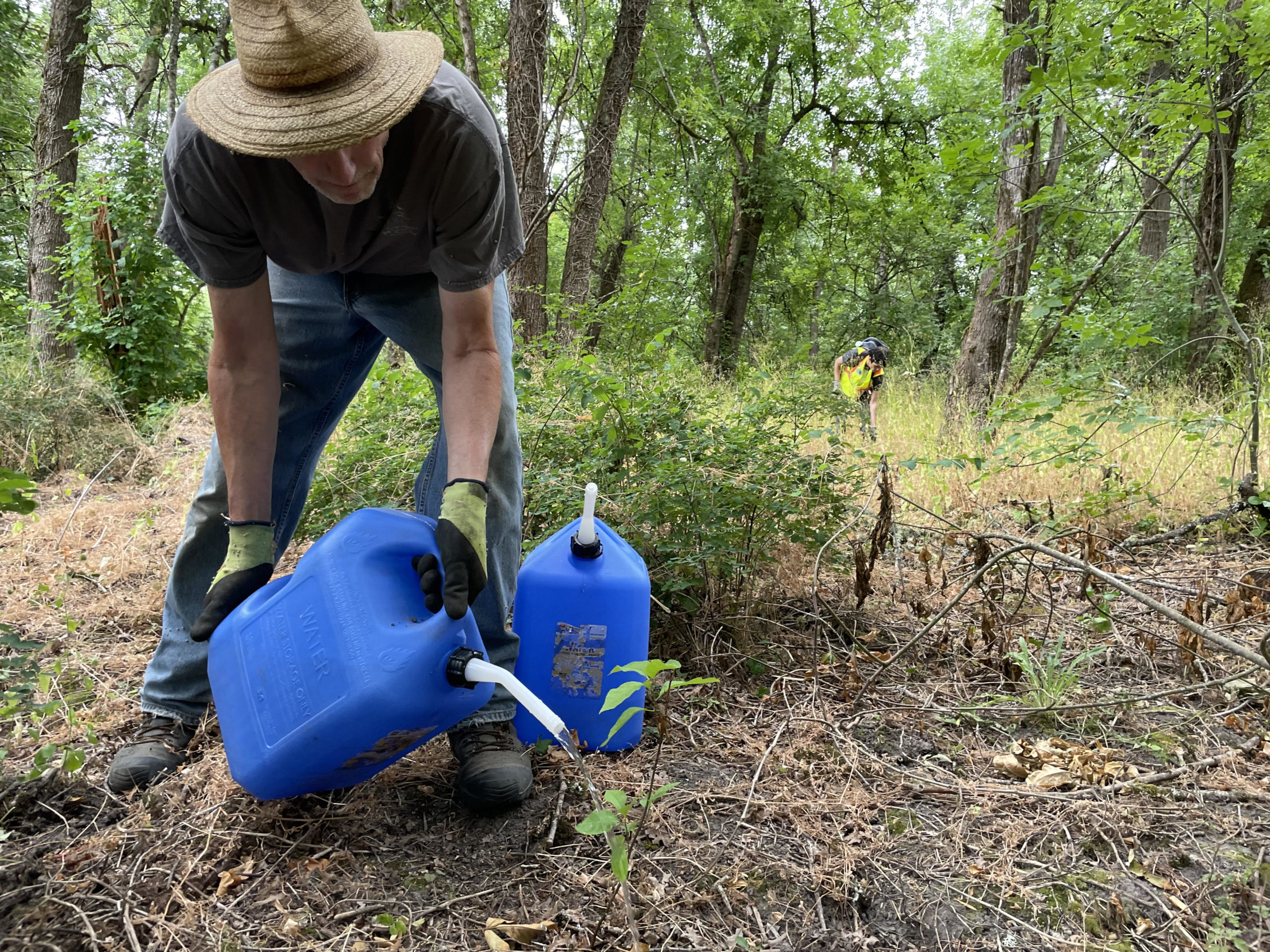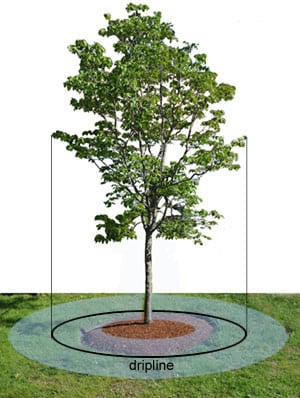The fingerprints of climate change are becoming more pronounced with the record crushing temperatures predicted for the Pacific Northwest. As prolonged heat and drought become part of the normal rhythms of the season, how do we take care of our trees? Unprecedented temperatures and seasons of drought can be extremely hard on trees, especially landscape trees in our urban forest. If not well-watered, harsh temperatures make trees more susceptible to insects and disease. Extended periods of drought can cause stress in both newly planted trees and mature, well-established trees.
Here are some tips collected from City of Lake Oswego, Friends of Trees, OSU Extension Master Gardeners and Portland Parks & Recreation to help you shift into summer plant care mode and help your landscapes better handle and recover from spans of extreme heat.
While this information is mainly focused on trees, OSU Extension offers a lot of great resources for identifying heat stress symptoms, such as leaf rolling and wilting, in other common Oregon native plants. Click here to learn more about how to treat stress symptoms in other beloved plants in your garden.

Drought Stress
- Plants that are subjected to water stress drastically decrease their resistance to opportunistic pathogens and insect invasions.
- Research your trees! Some species are more drought sensitive than others and require specific regional requirements for watering, soil quality and climate. Check out OSU Extension Service for recommended water-wise native plants and trees. For fire resistant selections, you can check out these guidelines.
- When monitoring drought stress, be on the lookout for sparse canopy, wilting foliage, yellowing of leaves, premature fall coloration or leaf drop.
Soil:
- Soil quality and type has a large impact on how successful a watering method is.
- If dried out for log intervals, some soil surfaces will not absorb water. You may think you’re deep soaking a tree only to find after observation that the water is merely shedding off the surface. Observe your soil. How quickly does it dry out after rain or watering? Dry soil can cause tree roots to die and reduce a tree’s ability to absorb water when it does finally rain.
- Sandy soils need shorter watering intervals because water drains quickly. Clay and less porous soils should have longer watering intervals.
- Soil moisture should be checked by hand! Portland Parks & Recreation suggests an easy way to test soil by inserting a long screwdriver or stick at least 6-12 inches into the ground below your tree to see how much resistance from the soil you receive. If you receive a lot of resistance, the tree needs more water. If there is mud sticking to the end of the screwdriver when you pull it up, the water has properly seeped into the root zone.
- Friends of Trees suggests mulching trees with 3-4 inches of organic mulch (woodchips, shredded bark) to reduce soil evaporation and maintain a consistent soil temperature. Do not apply mulch directly around the stem of a plant or the trunk of a tree.
General Watering Tips:
- It’s best to water trees in the early morning or late evening to minimize evaporation.
- Irrigate slowly so water percolates deep into the soil and root zone. This video by Friends of Trees demonstrates an effective, slow-drip watering system using a five-gallon drilled bucket.
- Other effective drip irrigation systems include: Ooze tubes, and soaker hoses
- When using hoses, make sure to move around different areas under the tree.
- Try not to water too much! Davey Trees has a helpful article about decoding your trees’ clues that they’re being overwatered.
- OSU Extension offers a detailed watering schedule and guidelines for different methods of watering here.
Tips for Watering Young Trees:
- Because most of the Pacific Northwest’s precipitation occurs in winter and early spring months, nature is not watering the young trees when they’re experiencing the most growth.
- Newly planted trees should be watered about two or three times a week in extremely hot, dry, windy weather because their root systems cannot take up the amount of water needed to replenish the water lost through the leaves week in their first three summers after planting. Amount of water should be tailored to tree size and need.
- It’s best to water infrequently, once or twice a week during long heat waves.
- Irrigate slowly and deeply to encourage roots to grow deeper.
- To encourage roots to grow outwards, avoid watering young trees too close to its trunk and stick to watering over the root zone between the trunk and the edge of its leafy canopy (dripline). This will expand the young tree’s drip line over the coming years.

6. This helpful video module by Friends of Trees demonstrates three different watering methods for young trees:
-
- You can purchase 15-20 gallon watering bags at a nursery to place around young trees. Fill once a week, or twice during heat waves.
- Drill three small holes a half inch apart into the base of a 5 gallon bucket. Fill three times during the course of the day and rotate it around the tree’s root zone.
- Place a trickling hose in the root zone for 15-30 minutes once a week.
Caring for Mature Trees:
- This video by USFS recommends slowly and deeply watering mature trees once to twice a month to keep them happy during dry months.
- Circle a soaker hose around the outer edge, or drip line, of the tree canopy. This is where water naturally drips off the tree canopy when it rains.
- Don’t water your mature tree at the base of the trunk. Too much water will rot the roots.
- Turn on your soaker hose in the early morning or late evening and turn on and let the water seep in for at least one hour.
- You may need to experiment with how much watering time is needed depending on the size of your tree.
Some types of care you should postpone or avoid during periods of hot weather:
Don’t plant or transplant
According to OSU Extension, too-warm soil temperatures can kill young seedlings, or cause cankers where the stem meets the soil line. Transplanting is stressful to plants without the added issues caused by high temperatures. OSU recommends postponing planting or transplanting until cooler temperatures arrive.
Don’t prune trees and shrubs
Removal of leaves and branches means a new part of the canopy will be exposed to sunlight. In times of intense heat, this can lead to sunburn in leaves that were previously shaded. Trees and shrubs with sunburn in a portion of the canopy will likely recover but will be unattractive in the meantime. Stressed trees are more likely to attract damaging insects like wood-boring beetles.
Don’t apply chemicals or fertilizers
Many treatments for plant disease and insect issues can damage plants when temperatures are consistently above 80F. Also avoid the use of pesticides and fertilizers during periods of extreme heat.
OSU Extension offers a detailed watering schedule and guidelines for different methods of watering here.
More Resources:
City of Lake Oswego Tree Code Archive
Oregon State University Extension Service Managing Heat Waves Archive
Friends of Trees Watering Guide
Article on drought recovery by Davey Tree Specialists
Portland Bureau of Environmental ServicesPortland Urban Forest Pro
Planting Trees for Climate Change
Mature Tree Care:
https://www.youtube.com/watch?v=lrirPBMTYi0
https://www.treesaregood.org/portals/0/docs/treecare/Mature_TreeCare.pdf
Clackamas Summer Watering Guide for Mature Trees
Young Tree Care:
https://www.youtube.com/watch?v=bcVbtFjnlJ4&list=PLnUkjfUlP5faTVSBVC6omv3-xepT6B0Cs&index=3
Portland Parks & Recreation article on heat stress in young trees
